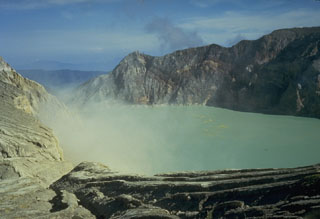Report on Ijen (Indonesia) — September 1999
Bulletin of the Global Volcanism Network, vol. 24, no. 9 (September 1999)
Managing Editor: Richard Wunderman.
Ijen (Indonesia) Increased seismicity since April 1999; white plumes and phreatic eruptions
Please cite this report as:
Global Volcanism Program, 1999. Report on Ijen (Indonesia) (Wunderman, R., ed.). Bulletin of the Global Volcanism Network, 24:9. Smithsonian Institution. https://doi.org/10.5479/si.GVP.BGVN199909-263350
Ijen
Indonesia
8.058°S, 114.242°E; summit elev. 2769 m
All times are local (unless otherwise noted)
Seismicity at Ijen increased starting in early April, when volcanic B-type events rose from 15 during the week ending on 5 April to 41 events during 6-12 April. Tremor during April and May had amplitudes of 0.5-2 mm. The number of B-type events remained high (more than 34/week) for most of the period through mid-June. Seismicity then gradually declined through mid-July, after which the weekly number of B-type events remained stable at an average of 9/week. During the period of 18 May through the week ending on 21 June a "white ash plume" rose 50-100 m. Recorded tremor had an amplitude of 0.5-3 mm.
Two phreatic eruptions occurred at the Sibanteng location inside the active crater lake at 0510 on 28 June. An accompanying detonation was heard at the sulfur mining site 2 km from the summit and volcanic tremor was recorded with an amplitude of 0.5-1 mm. The following week, 6-12 July, yellow-gray sulfur emissions were observed from the crater and a loud "whizz" noise was heard. The crater lake's water was brownish-white and had sulfur agglutinate floating on the surface. Measurements on 8 July showed that the hotspring temperature was 48°C, air temperature at the crater lake was 15°C, the lakewater temperature was 40°C, and the sulfur gas temperature was 207-221°C. Thick haze prevented observations from 13 July through 23 August, but B-type events and continuous tremor was recorded. When J.M. Bardintzeff visited, on 17 August 1999, the solfatara was strongly active and the crater filled with gas. The acid lake was a pale-green color.
Conductivity determinations were made of acid lake waters sampled on 7 December 1998 (BGVN 23:11) by Bardintzeff, Marlin, and Barsuglia. Conductivity in the middle of the lake was 146 mS/cm. Near the S side it was 140 and only 98-120 mS/cm near the hot sub-lacustrine spring. A small affluent in the S side, was (from its source to the lake) 39-27°C, with a pH of 1.6, and conductivity of 17 mS/cm. In the Banyupahit River, 3 km from the dam, conductivity was 138 mS/cm. On 10 December 1998 conductivity in the middle of the lake was 181 mS/cm.
Geological Summary. The Ijen volcano complex at the eastern end of Java consists of a group of small stratovolcanoes constructed within the 20-km-wide Ijen (Kendeng) caldera. The north caldera wall forms a prominent arcuate ridge, but elsewhere the rim was buried by post-caldera volcanoes, including Gunung Merapi, which forms the high point of the complex. Immediately west of the Gunung Merapi stratovolcano is the historically active Kawah Ijen crater, which contains a nearly 1-km-wide, turquoise-colored, acid lake. Kawah Ijen is the site of a labor-intensive mining operation in which baskets of sulfur are hand-carried from the crater floor. Many other post-caldera cones and craters are located within the caldera or along its rim. The largest concentration of cones forms an E-W zone across the southern side of the caldera. Coffee plantations cover much of the caldera floor; nearby waterfalls and hot springs are tourist destinations.
Information Contacts: Volcanological Survey of Indonesia (VSI), Jalan Diponegoro No. 57, Bandung 40122, Indonesia (URL: http://www.vsi.esdm.go.id/); J.M. Bardintzeff; C. Marlin, and F. Barsuglia, Sciences de la Terre, bat 504, Universite Paris-Sud, 91405 Orsay cedex, France.

